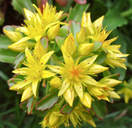|
Ozark Green Thumb BCMG Monthly e-Newsletter |
|
|
 Plants come and go in the nursery trade with a dizzying rapidity. Here today, gone tomorrow. The causes for this seeming fickleness are many, but ultimately it boils down to growing what people will buy. Sedums, in their many and varied forms, are popular plants across the land but two species, the lowly stonecrop (Sedum acre) and stringy stonecrop (S. sarmentosum) have fallen from favor and are seldom seen in commercial offerings. Both plants are often called goldmoss sedum. Sedum acre is a mat forming succulent perennial that grows about 3 inches tall with tangled stems that spread horizontally by means of a shallow rhizome. The rounded quarter-inch long leaf is tightly held against the stem. The small but showy yellow flowers appear in mid-spring on flat-topped cymes. Individual flowers form five-pointed stars with protruding stamens. Sedums are members of the succulent crassula family. Sedum acre is native to a wide swath of Eurasia and was introduced early into North America. It has escaped cultivation in most of our northern states and most Canadian provinces. It grows as far north as zone 2, at least when protected by snow cover. It does not appear to have escaped in the South. As an escapee, it is primarily found on open, barren and rocky ground where little else will grow. In certain fragile ecosystems, such as “balds” and broad limestone ledges where there is almost no soil, it can displace native species. Sedum sarmentosum, stringy stonecrop, is a Chinese native, with arching above ground stems that produce succulent, triangular leaves about a half-inch long that decrease in size towards the ends of the branches. Plants have a chartreuse look about them, especially in the spring. It is a sprawling plant that grows to about 4 inches tall, with most of the action above ground, whereas Sedum acre spreads primarily by underground rhizomes. Stringy stonecrop is the most aggressive spreader in the South and has escaped cultivation in the eastern states, where it is sometimes called graveyard stonecrop. Gardeners seem to love or hate goldmoss sedums in about equal numbers. Their aggressive ways make them sure survivors in almost any site, and if your site is sunny and open it can spread and become invasive. But, because they stay on the ground and only sprawl sideways, they will not spread far under the shade of tall growing perennials or shrubs. Some gardeners use them as “living mulch” by allowing their thick mat of foliage to cover the ground and suppress weeds. The gardeners at Arlington National Cemetery in Virginia have planted Sedum acre between the granite slabs marking President Kennedy’s grave, where it has persisted for almost 50 years. Sedums of all kinds, including both species of goldmoss sedum, have found new life in recent years as a major component of living roofs. The green roof movement, while not common in Arkansas, is being used extensively in many large cities. The green roof concept relies on a very permeable soil that is usually composed of a lightweight coarse aggregate that comprises 85 percent of the soil volume. This allows for rapid water penetration during rains, but means the plants must be both heat- and drought-tolerant. Sedums have served well in this capacity. Both goldmoss sedums are hardy from zones 3 through 8 (9) and will grow in almost any soil, but must have at least 6 hours of sun to survive. If the soil conditions are fertile, it might be a mistake to plant such aggressive growers, but it the site is harsh, then they may be a good choice. They can be easily restrained by pulling the shallowly rooted plants from areas where it is not wanted. New plantings can be established by plopping a handful of plants on top of the soil and then occasionally watering it until new roots establish. By: Gerald Klingaman, retired
Retired Extension Horticulturist - Ornamentals Extension News - June 17, 2011
0 Comments
Leave a Reply. |
Archives
April 2022
|
|
